Impact of Soil Compaction on Pore Characteristics and Hydraulic Properties by Using X-Ray CT and Soil Water Retention Curve in China’s Loess Plateau
Abstract
:1. Introduction
2. Materials and Methods
2.1. Soil Description
2.2. Soil Sampling, Analysis and Compaction
2.3. CT Scanning and Image Analysis
2.4. Measurement of Soil Water Retention, Hydraulic Conductivity, and Soil Pore
2.5. Statistical Analysis
3. Results and Discussion
3.1. Soil Physical Properties and Ct-Based Pore Characteristics Under Compaction Levels for Varying Locations
3.2. SWRC, Hydraulic Conductivity Based on SWRC and MDI Parameters
3.3. Estimation of Pore Size Distribution Based on SWRC and Comparison with CT
3.4. Relationships Between Soil Physical Properties, SWRC, Hydraulic Conductivity, and Pore Characteristics
4. Conclusions
Author Contributions
Funding
Data Availability Statement
Acknowledgments
Conflicts of Interest
Abbreviations
| CT | X-ray Computed Tomography |
| SOC | Soil Organic Carbon |
| φ-CT | CT-based total porosity |
| CP | Connectivity Porosity |
| Vp | Pore Volume |
| A | Surface area |
| Dm | Minimum diameter |
| Dx | Maximum diameter |
| PN | Pore Number |
| TN | Throats Number |
| VWCo | Volumetric Water Content observe |
| VWCp | Volumetric Water Content predict |
| Ks | Saturated hydraulic conductivity |
| SWRC | Soil Water Retention Curve |
| Kun | Unsaturated hydraulic conductivity |
| Kun-SWRC | Unsaturated hydraulic conductivity based on SWRC |
| MDI | Mini Disc Infiltrometer |
| Kun-MDI | Unsaturated hydraulic conductivity based on MDI |
| θs | Saturated water content |
| θr | Residual water content |
| α, n | van Genuchten model parameters |
| FC | Field Capacity |
| WP | Wilting Point |
| AW | Available Water |
| RFC | Relative Field Capacity |
| RP | Residual Pores |
| SP | Storage Pores |
| TP | Transmission Pores |
| φ-SWRC | SWRC-based total porosity |
Appendix A
| Parameter | Suffix Pattern | Interpretation |
|---|---|---|
| Sand (%) | a, b, c, d, e | Each location has distinct sand content (e.g., Shenmu [e] > Yangling [a]) |
| Silt (%) | a, b, c, d | Shenmu (a) has the lowest silt; Chunhua/Yangling (d) share the highest |
| Clay (%) | a, b, c, d | Clay increases sequentially: Shenmu (a) < Suide (b) < Fuxian/Chunhua (c) < Yangling (d) |
| SOC (g kg−1) | a, b, c, d, e | SOC increases strictly from Shenmu (a) to Yangling (e); no overlaps |
| φ-CT (%) | a, b, c, d | Total porosity: Shenmu (a) < Suide/Fuxian (b) < Chunhua (c) < Yangling (d) |
| CP (%) | a, b, c | Connectivity porosity: Shenmu (a) < Suide/Fuxian (b) < Chunhua/Yangling (c) |
| Vp (µm) | a, ab, b, c | Pore volume decreases from Shenmu (c) to Yangling (a); Chunhua (ab) overlaps |
| A (mm) | a, ab, b, c | Surface area trends mirror Vp; Chunhua (ab) bridges “a” and “b” groups |
| Dm (µm) | a, ab, b | Minimum pore diameter: Yangling (a) < Suide/Fuxian/Chunhua (ab) < Shenmu (b) |
| Dx (µm) | a, ab, b, c | Maximum pore diameter decreases from Shenmu (c) to Yangling (a); overlaps in mid-groups (ab, b) |
| PN | a, b, c, d | Pore number increases sequentially; all groups are distinct |
| TN | a, b, c, d | Throat number follows the same trend as PN; Yangling (d) has the highest TN |
References
- Blanco-Canqui, H.; Lal, R. Principles of Soil Conservation and Management; Springer: Dordrecht, The Netherland, 2010; pp. 1–617. [Google Scholar] [CrossRef]
- Rabot, E.; Wiesmeier, M.; Schlüter, S.; Vogel, H.J. Soil Structure as an Indicator of Soil Functions: A Review. Geoderma 2018, 314, 122–137. [Google Scholar] [CrossRef]
- Wolf, M.K.; Wiesmeier, M.; Macholdt, J. Importance of Soil Fertility for Climate-Resilient Cropping Systems: The Farmer’s Perspective. Soil Secur. 2023, 13, 100119. [Google Scholar] [CrossRef]
- Shi, H.; Shao, M. Soil and Water Loss from the Loess Plateau in China. J. Arid Environ. 2000, 45, 9–20. [Google Scholar] [CrossRef]
- Wang, L.; Shao, M.; Wang, Q.; Gale, W.J. Historical Changes in the Environment of the Chinese Loess Plateau. Environ. Sci. Policy 2006, 9, 675–684. [Google Scholar] [CrossRef]
- Wang, Q.X.; Fan, X.H.; Qin, Z.D.; Wang, M.B. Change Trends of Temperature and Precipitation in the Loess Plateau Region of China, 1961–2010. Glob. Planet Change 2012, 92–93, 138–147. [Google Scholar] [CrossRef]
- Liu, W.; Sang, T. Potential Productivity of the Miscanthus Energy Crop in the Loess Plateau of China under Climate Change. Environ. Res. Lett. 2013, 8, 044003. [Google Scholar] [CrossRef]
- Lehmann, J.; Bossio, D.A.; Kögel-Knabner, I.; Rillig, M.C. The Concept and Future Prospects of Soil Health. Nat. Rev. Earth Environ. 2020, 1, 544–553. [Google Scholar] [CrossRef]
- Shaheb, M.R.; Venkatesh, R.; Shearer, S.A. A Review on the Effect of Soil Compaction and Its Management for Sustainable Crop Production. J. Biosyst. Eng. 2021, 46, 417–439. [Google Scholar] [CrossRef]
- Lipiec, J.; Horn, R.; Pietrusiewicz, J.; Siczek, A. Effects of Soil Compaction on Root Elongation and Anatomy of Different Cereal Plant Species. Soil Tillage Res. 2012, 121, 74–81. [Google Scholar] [CrossRef]
- Alaoui, A.; Lipiec, J.; Gerke, H.H. A Review of the Changes in the Soil Pore System Due to Soil Deformation: A Hydrodynamic Perspective. Soil Tillage Res. 2011, 115–116, 1–15. [Google Scholar] [CrossRef]
- Reynolds, W.D.; Drury, C.F.; Tan, C.S.; Fox, C.A.; Yang, X.M. Use of Indicators and Pore Volume-Function Characteristics to Quantify Soil Physical Quality. Geoderma 2009, 152, 252–263. [Google Scholar] [CrossRef]
- Six, J.; Bossuyt, H.; Degryze, S.; Denef, K. A History of Research on the Link between (Micro)Aggregates, Soil Biota, and Soil Organic Matter Dynamics. Soil Tillage Res. 2004, 79, 7–31. [Google Scholar] [CrossRef]
- Zhang, S.; Grip, H.; Lövdahl, L. Effect of Soil Compaction on Hydraulic Properties of Two Loess Soils in China. Soil Tillage Res. 2006, 90, 117–125. [Google Scholar] [CrossRef]
- Tian, Z.; Chen, J.; Cai, C.; Gao, W.; Ren, T.; Heitman, J.L.; Horton, R. New Pedotransfer Functions for Soil Water Retention Curves That Better Account for Bulk Density Effects. Soil Tillage Res. 2021, 205, 104812. [Google Scholar] [CrossRef]
- Feng, R.; Zhang, Y.; Wang, J.; Wang, Y.; Zhang, N.; She, D. Effects of Rainfall-Induced Physical Crusts on Soil Carbon Distribution and Mineralization through Surface Pore Structure. Soil Tillage Res. 2025, 247, 106373. [Google Scholar] [CrossRef]
- Jiang, Z.; Pan, Y.; Fu, C.; Li, W.; Wang, Y.; Long, W.J. Three-Dimensional Pore Structure Characterization of Cement Paste by X-Ray Computed Tomography (XCT) and Focused Ion Beam/Scanning Electron Microscopy (FIB/SEM). Constr. Build. Mater. 2023, 383, 131379. [Google Scholar] [CrossRef]
- Lal, R.; Shukla, M.K. Principles of Soil Physics; CRC Press: Boca Raton, FL, USA, 2004. [Google Scholar] [CrossRef]
- Dlapa, P.; Hriník, D.; Hrabovský, A.; Šimkovic, I.; Žarnovican, H.; Sekucia, F.; Kollár, J. The Impact of Land-Use on the Hierarchical Pore Size Distribution and Water Retention Properties in Loamy Soils. Water 2020, 12, 339. [Google Scholar] [CrossRef]
- Mady, A.Y.; Shein, E.V.; Abrosimov, K.N.; Skvortsova, E.B. X-Ray Computed Tomography: Validation of the Effect of Pore Size and Its Connectivity on Saturated Hydraulic Conductivity. Soil Environ. 2021, 40, 1–8. [Google Scholar] [CrossRef]
- Talat, A.E.; Feng, R.; Liu, G.; Xie, J.; Cai, Z.; Wang, J. Simulated Experimental Effect of Bulk Density on Infiltration Rate of China’s Loess Plateau. Egypt. J. Soil Sci. 2025, 65, 239–252. [Google Scholar] [CrossRef]
- Graefe, U.; Baritz, R.; Broll, G.; Kolb, E.; Milbert, G.; Wachendorf, C. Adapting humus form classification to WRB principles. In Proceedings of the 4th International Congress of the European Soil Science Societies—Eurosoil, Bari, Italy, 2–6 July 2012; p. 954. [Google Scholar]
- Klute, A. Water Retention: Laboratory Methods. In Methods of Soil Analysis; Part 1—Physical and Mineralogical Methods, 2nd ed.; Klute, A., Ed.; ASA & SSSA: Madison, WI, USA, 1986; pp. 635–662. [Google Scholar] [CrossRef]
- Houghton, J.I.; Burgess, J.E.; Stephenson, T. Off-line particle size analysis of digested sludge. Water Res. 2002, 36, 4643–4647. [Google Scholar] [CrossRef]
- Nelson, D.W.; Sommers, L.E. Total carbon, organic carbon, and organic matter. Methods Soil Anal. Part 3-Chem. Methods 1996, 5, 961–1010. [Google Scholar] [CrossRef]
- Mbarki, Y.; Gumiere, S.J.; Celicourt, P.; Brédy, J. Study of the Effect of the Compaction Level on the Hydrodynamic Properties of Loamy Sand Soil in an Agricultural Context. Front. Water 2023, 5, 1255495. [Google Scholar] [CrossRef]
- Li, Z.; Wu, P.; Feng, H.; Zhao, X.; Huang, J.; Zhuang, W. Simulated Experiment on Effect of Soil Bulk Density on Soil Infiltration Capacity. Nongye Gongcheng Xuebao/Trans. Chin. Soc. Agric. Eng. 2009, 25, 40–45. [Google Scholar] [CrossRef]
- Feng, R.; Liu, G.; Chen, Y.; Wang, C.; Zhang, Q.; Wang, J. Impacts of Rainfall-Induced Physical Crust on near-Surface Soil Pore Structure after Drying. Catena 2024, 238, 107800. [Google Scholar] [CrossRef]
- Thomson, P.R.; Aituar-Zhakupova, A.; Hier-Majumder, S. Image Segmentation and Analysis of Pore Network Geometry in Two Natural Sandstones. Front. Earth Sci. 2018, 6, 58. [Google Scholar] [CrossRef]
- van Genuchten, M.T. A closed form equation for predicting the hydraulic conductivity of unsaturated soils. Soil Sci. Soc. Am. J. 1980, 44, 892–898. [Google Scholar] [CrossRef]
- Mualem, Y. Hydraulic Conductivity of Unsaturated Soils: Prediction and Formulas. In Methods of Soil Analysis; John and Wiley and Sons: Hoboken, NJ, USA; Wiley: Hoboken, NJ, USA, 1986; pp. 799–823. [Google Scholar] [CrossRef]
- Reynolds, W.D.; Drury, C.F.; Yang, X.M.; Tan, C.S. Optimal Soil Physical Quality Inferred through Structural Regression and Parameter Interactions. Geoderma 2008, 146, 466–474. [Google Scholar] [CrossRef]
- Antinoro, C.; Arnone, E.; Noto, L.V. The Use of Soil Water Retention Curve Models in Analyzing Slope Stability in Differently Structured Soils. Catena 2017, 150, 133–145. [Google Scholar] [CrossRef]
- Wu, X.; Wei, Y.; Wang, J.; Wang, D.; She, L.; Wang, J.; Cai, C. Effects of Soil Physicochemical Properties on Aggregate Stability along a Weathering Gradient. Catena 2017, 156, 205–215. [Google Scholar] [CrossRef]
- Zhou, Y.; Cheng, T. Influence of Natural Organic Matter in Porous Media on Fine Particle Transport. Sci. Total Environ. 2018, 627, 176–188. [Google Scholar] [CrossRef]
- Yom-Tov, O.; Neufeld, L.; Seliktar, D.; Bianco-Peled, H. A Novel Design of Injectable Porous Hydrogels with in Situ Pore Formation. Acta Biomater. 2014, 10, 4236–4246. [Google Scholar] [CrossRef] [PubMed]
- Kan, X.; Zheng, W.; Cheng, J.; Zhangzhong, L.; Li, J.; Liu, B.; Zhang, X. Investigating Soil Pore Network Connectivity in Varied Vegetation Types Using X-Ray Tomography. Water 2023, 15, 3823. [Google Scholar] [CrossRef]
- Weil, R.; Brady, N.C. Chapter 12: Soil Organic Matter. In Nature and Properties of Soils, 15th ed.; Pearson Education: London, UK, 2017; pp. 526–582. [Google Scholar]
- Arthur, E.; Schjønning, P.; Moldrup, P.; Tuller, M.; de Jonge, L.W. Density and Permeability of a Loess Soil: Long-Term Organic Matter Effect and the Response to Compressive Stress. Geoderma 2013, 193–194, 236–245. [Google Scholar] [CrossRef]
- Kay, B.D.; VandenBygaart, A.J. Conservation Tillage and Depth Stratification of Porosity and Soil Organic Matter. Soil Tillage Res. 2002, 66, 107–118. [Google Scholar] [CrossRef]
- Fu, Y.; Tian, Z.; Amoozegar, A.; Heitman, J. Measuring Dynamic Changes of Soil Porosity during Compaction. Soil Tillage Res. 2019, 193, 114–121. [Google Scholar] [CrossRef]
- Hamza, M.A.; Anderson, W.K. Soil Compaction in Cropping Systems: A Review of the Nature, Causes and Possible Solutions. Soil Tillage Res. 2005, 82, 121–145. [Google Scholar] [CrossRef]
- Hu, W.; Cichota, R.; Beare, M.; Müller, K.; Drewry, J.; Eger, A. Soil Structural Vulnerability: Critical Review and Conceptual Development. Geoderma 2023, 430, 116346. [Google Scholar] [CrossRef]
- Mady, A.Y.; Abdelhamid, M.A.; Shalaby, L.A.; Saeed, M.A. Evaluation of Pedotransfer Functions to Estimate Saturated Hydraulic Conductivity Using Machine Learning with Random Forest and Gradient Boosting Algorithms. Soil Environ. 2024, 43, 268–277. [Google Scholar] [CrossRef]
- Xiao, Z.; Yu, N.; An, J.; Zou, H.; Zhang, Y. Soil Compressibility and Resilience Based on Uniaxial Compression Loading Test in Response to Soil Water Suction and Soil Organic Matter Content in Northeast China. Sustainability 2022, 14, 2620. [Google Scholar] [CrossRef]
- Lipiec, J.; Medvedev, V.V.; Birkas, M.; Dumitru, E.; Lyndina, T.E.; Rousseva, S.; Fulajtar, E. Effect of Soil Compaction on Root Growth and Crop Yield in Central and Eastern Europe. Int. Agrophys. 2003, 17, 2. [Google Scholar]
- Talat, A.E.; Galal, M.E.; Yeser, A.; Saad El-Dein, A.A. Quantifying the Hydraulic Properties of Some Egyptian Soils Using RETC Code. Arab. Univ. J. Agric. Sci. 2020, 28, 685–694. [Google Scholar] [CrossRef]
- Luo, S.; Zhou, B.; Likos, W.J.; Lu, N. Determining Capillary Pore–Size Distribution of Soil from Soil–Water Retention Curve. J. Geotech. Geoenvironmental Eng. 2023, 150, 04023138. [Google Scholar] [CrossRef]
- Xu, Y.; Jimenez, M.A.; Parent, S.É.; Leblanc, M.; Ziadi, N.; Parent, L.E. Compaction of Coarse-Textured Soils: Balance Models across Mineral and Organic Compositions. Front. Ecol. Evol. 2017, 5, 83. [Google Scholar] [CrossRef]
- Ni, S.; Zhang, D.; Wen, H.; Cai, C.; Wilson, G.V.; Wang, J. Erosion Processes and Features for a Coarse-Textured Soil with Different Horizons: A Laboratory Simulation. J. Soils Sediments 2020, 20, 2997–3012. [Google Scholar] [CrossRef]
- Matus, F.J. Fine Silt and Clay Content Is the Main Factor Defining Maximal C and N Accumulations in Soils: A Meta-Analysis. Sci. Rep. 2021, 11, 6438. [Google Scholar] [CrossRef]
- Mahmoodlu, M.G.; Raoof, A.; Sweijen, T.; van Genuchten, M.T. Effects of Sand Compaction and Mixing on Pore Structure and the Unsaturated Soil Hydraulic Properties. Vadose Zone J. 2016, 15, 1–11. [Google Scholar] [CrossRef]
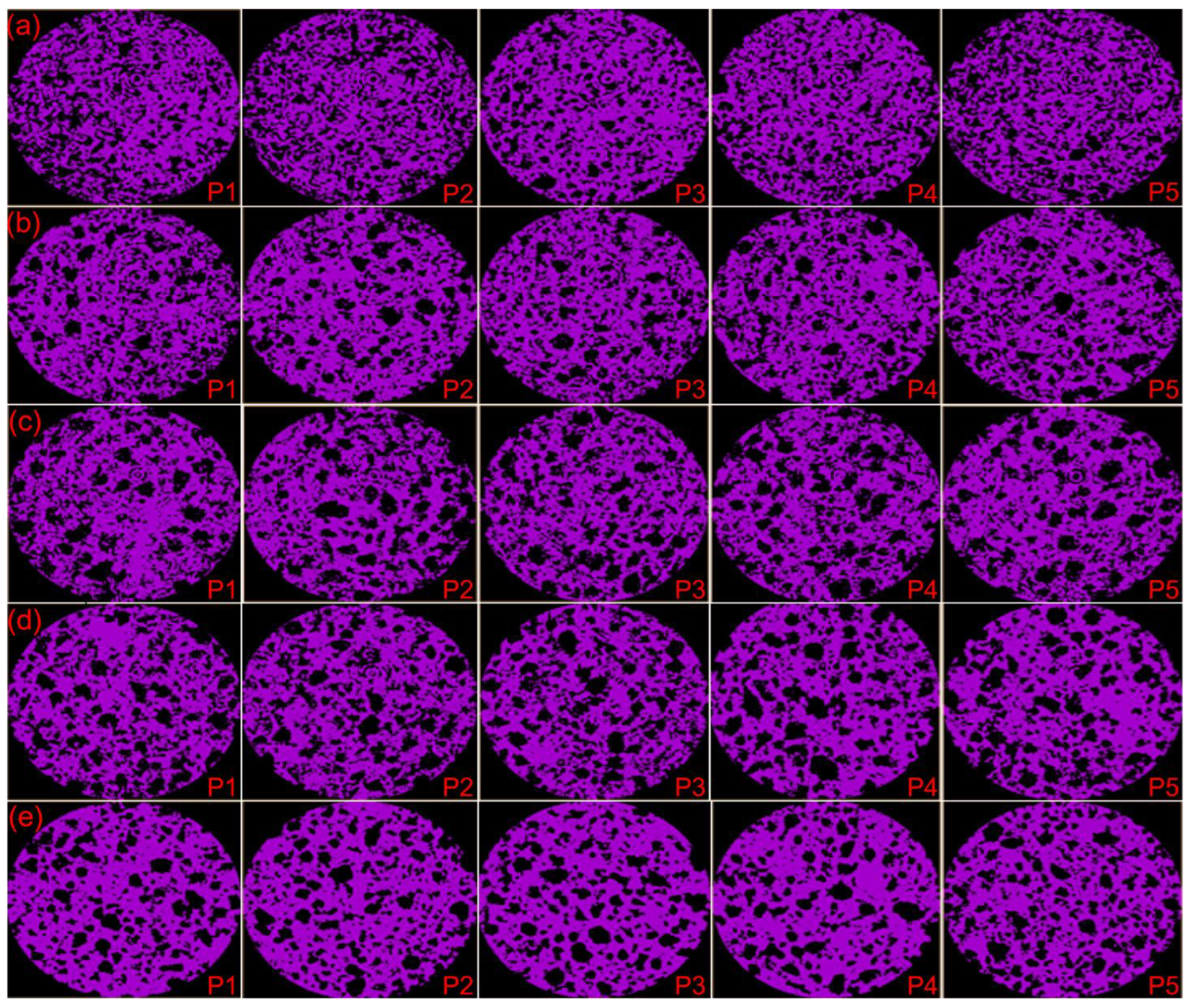
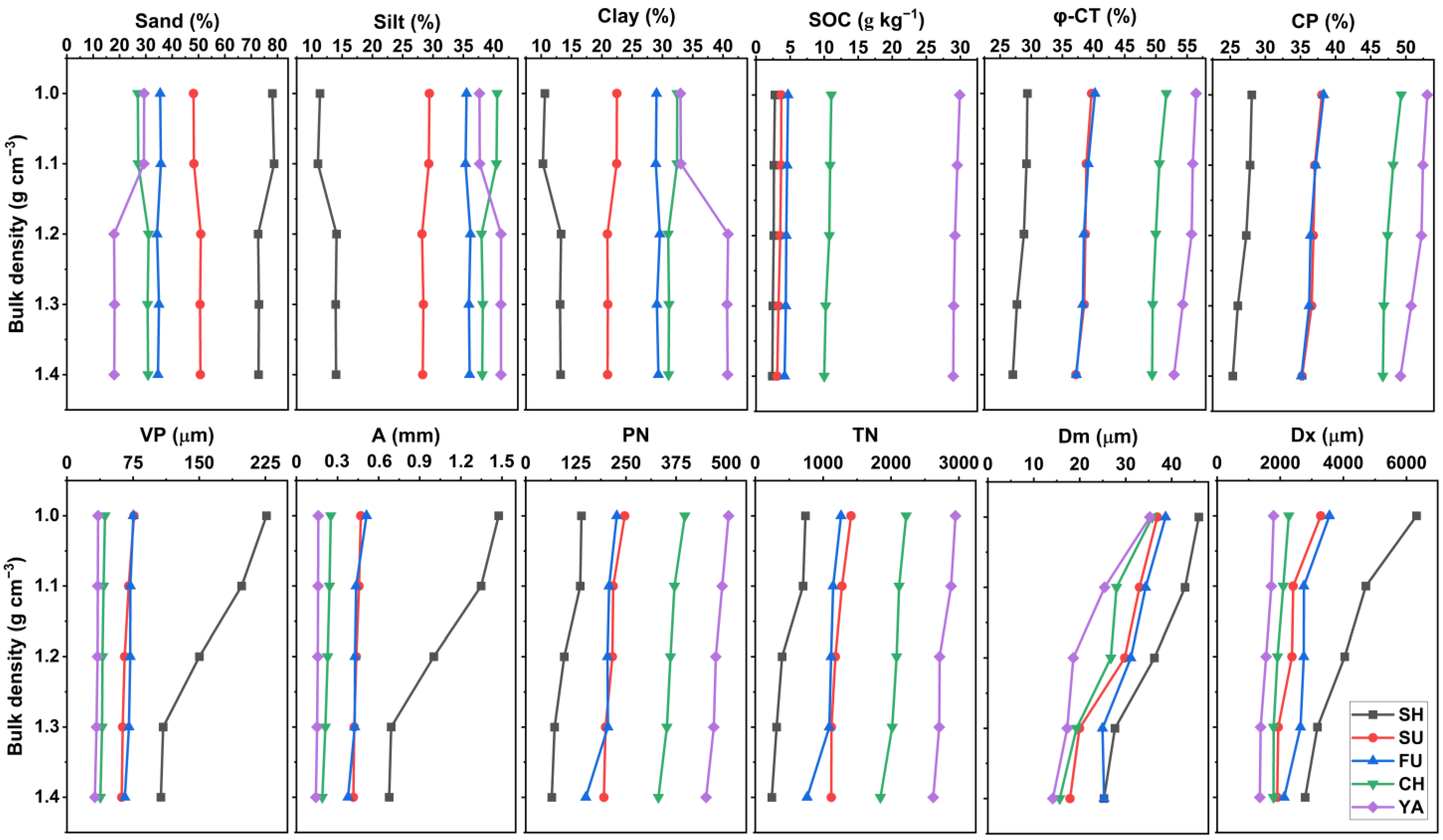
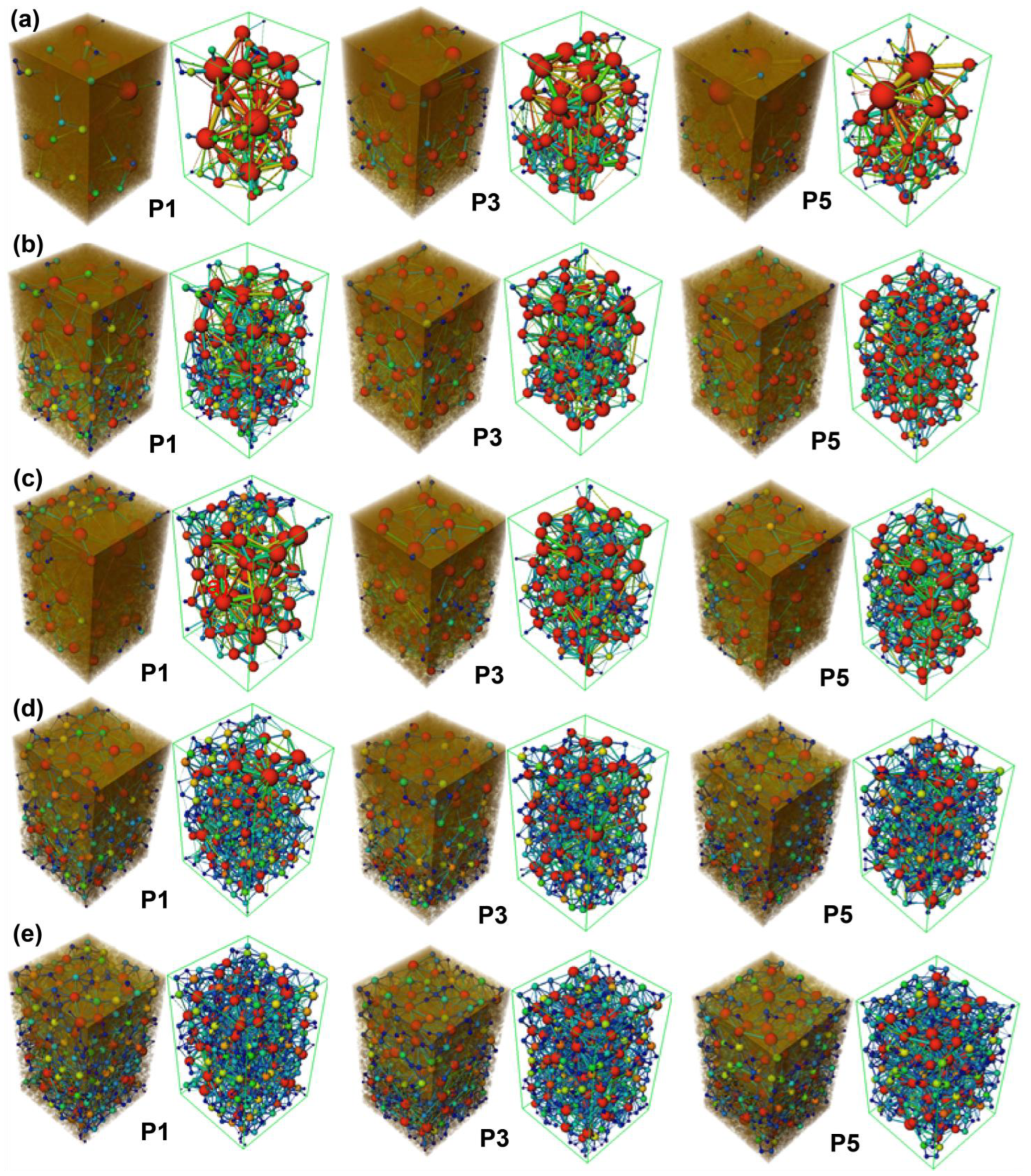

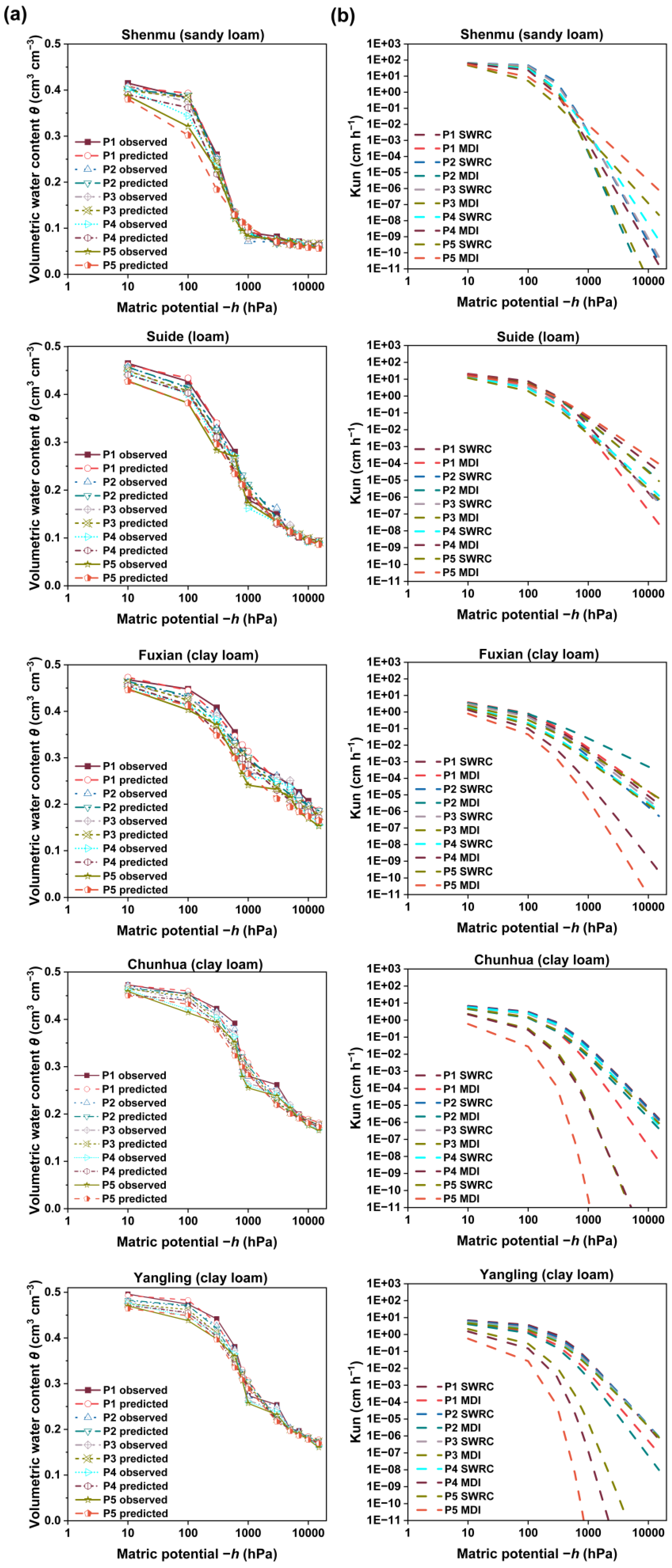
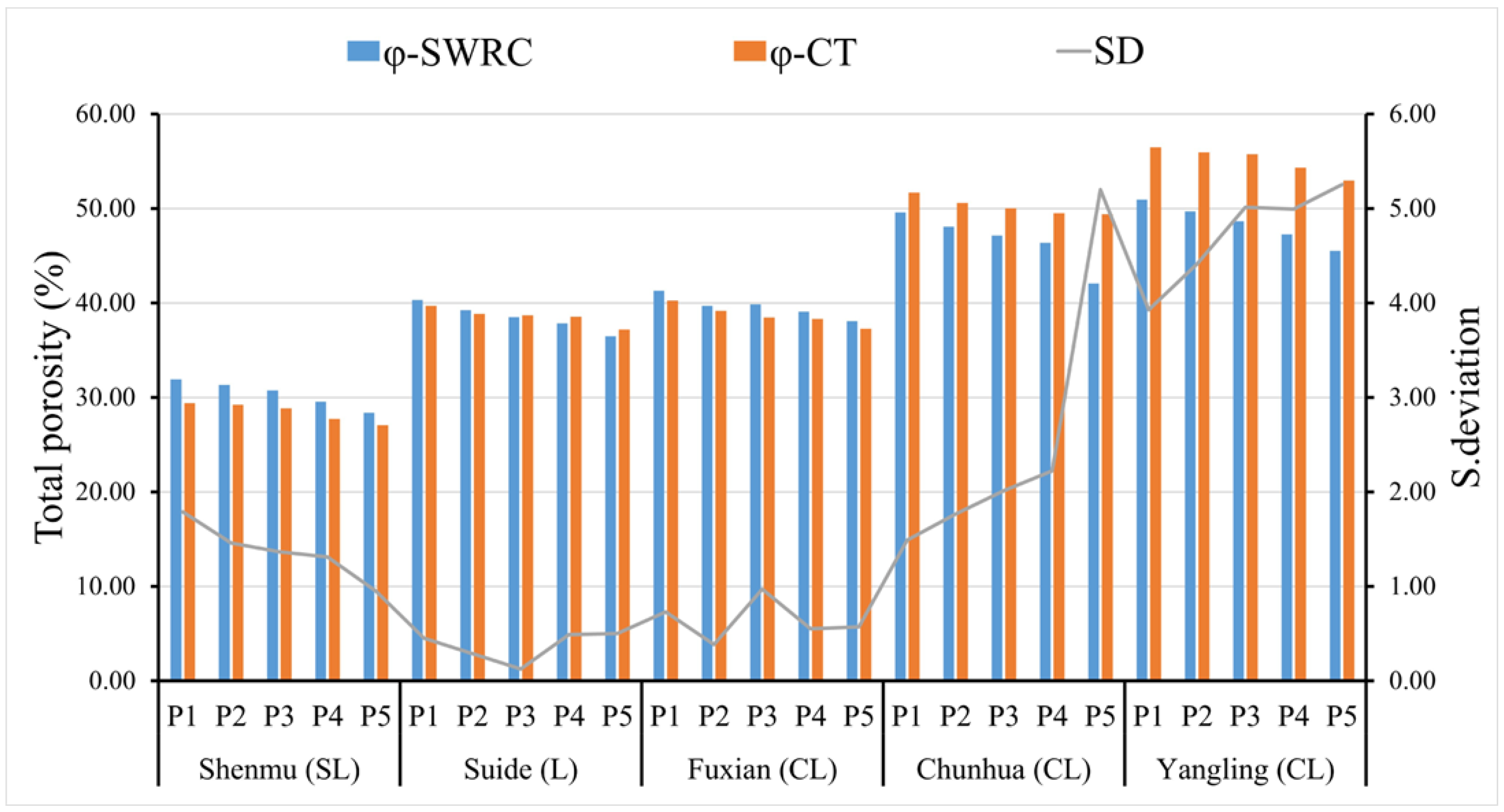
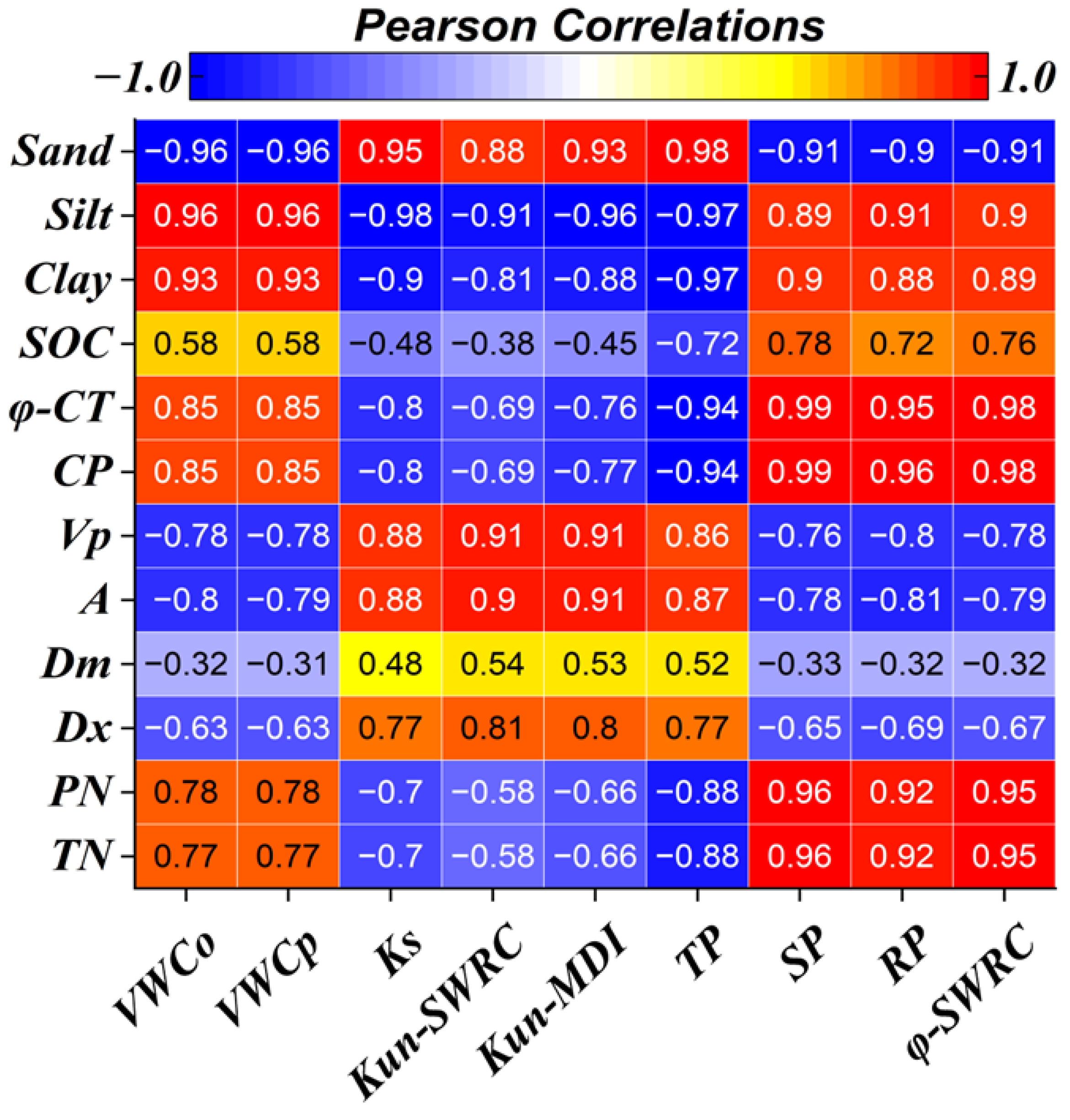
| Location and Soil Texture | Soil Physical Properties | Pore Characteristics Using X-Ray CT | ||||||||||
|---|---|---|---|---|---|---|---|---|---|---|---|---|
| Sand | Silt | Clay | SOC | φ-CT | CP | Vp | A | Dm | Dx | PN | TN | |
| (%) | (%) | (%) | (g kg−1) | (%) | (%) | (μm) | (mm) | (μm) | (μm) | |||
| Shenmu (SL) | 75.0 e | 12.9 a | 12.1 a | 2.57 a | 28.4 a | 26.9 a | 158 c | 1.04 c | 35.6 b | 4209.1 c | 102 a | 479 a |
| Suide (L) | 49.7 d | 28.7 b | 21.6 b | 3.47 b | 38.6 b | 36.7 b | 71.0 b | 0.44 b | 30.9 ab | 2764.2 b | 199 b | 1077 b |
| Fuxian (CL) | 35.0 c | 35.8 c | 29.2 c | 4.45 c | 38.7 b | 36.8 b | 67.4 b | 0.43 b | 27.5 ab | 2381.3 ab | 215 b | 1223 b |
| Chunhua (CL) | 29.3 b | 39.1 d | 31.6 c | 10.6 d | 50.2 c | 47.7 c | 40.5 ab | 0.22 ab | 25.1 ab | 1972.2 ab | 362 c | 2057 c |
| Yangling (CL) | 22.5 a | 39.8 d | 37.7 d | 29.3 e | 55.1 d | 51.6 c | 34.1 a | 0.15 a | 22.1 a | 1559.2 a | 478 d | 2776 d |
| Soil Physical Properties | Pore Characteristics Using X-Ray CT | |||||||
|---|---|---|---|---|---|---|---|---|
| φ-CT | CP | Vp | A | Dm | Dx | PN | TN | |
| Sand | −0.899 ** | −0.899 ** | 0.873 ** | 0.885 ** | 0.519 ** | 0.774 ** | −0.831 ** | −0.828 ** |
| Silt | 0.875 ** | 0.878 ** | −0.889 ** | −0.895 ** | −0.492 ** | −0.774 ** | 0.791 ** | 0.789 ** |
| Clay | 0.906 ** | 0.901 ** | −0.837 ** | −0.855 ** | −0.537 ** | −0.757 ** | 0.857 ** | 0.852 ** |
| SOC | 0.841 ** | 0.825 ** | −0.545 ** | −0.579 ** | −0.410 * | −0.562 ** | 0.902 ** | 0.899 ** |
| Location and Soil Texture | Compaction Levels | θs | θr | α | n | FC | WP | AW | RFC | Ks | |||
|---|---|---|---|---|---|---|---|---|---|---|---|---|---|
| (cm3 cm−3) | (cm−1) | (cm3 cm−3) | cm h−1 | ||||||||||
| Shenmu (SL) | P1 | 0.415 | 0.260 | 0.060 | 0.200 | 0.627 | 69.80 | ||||||
| P2 | 0.408 | 0.252 | 0.064 | 0.188 | 0.618 | 66.20 | |||||||
| P3 | 0.407 | 0.065 | 0.075 | 1.89 | 0.244 | 0.064 | 0.180 | 0.600 | 65.10 | ||||
| P4 | 0.402 | 0.232 | 0.059 | 0.174 | 0.578 | 64.30 | |||||||
| P5 | 0.387 | 0.227 | 0.058 | 0.169 | 0.587 | 62.70 | |||||||
| Suide (L) | P1 | 0.465 | 0.339 | 0.094 | 0.245 | 0.729 | 24.20 | ||||||
| P2 | 0.457 | 0.329 | 0.091 | 0.238 | 0.720 | 22.85 | |||||||
| P3 | 0.451 | 0.078 | 0.036 | 1.56 | 0.311 | 0.090 | 0.221 | 0.690 | 21.90 | ||||
| P4 | 0.443 | 0.300 | 0.090 | 0.210 | 0.677 | 20.40 | |||||||
| P5 | 0.428 | 0.283 | 0.090 | 0.193 | 0.661 | 19.80 | |||||||
| Fuxian (CL) | P1 | 0.468 | 0.408 | 0.162 | 0.246 | 0.872 | 8.22 | ||||||
| P2 | 0.462 | 0.398 | 0.160 | 0.238 | 0.861 | 7.55 | |||||||
| P3 | 0.458 | 0.095 | 0.019 | 1.31 | 0.390 | 0.157 | 0.233 | 0.852 | 7.15 | ||||
| P4 | 0.453 | 0.382 | 0.155 | 0.227 | 0.843 | 6.78 | |||||||
| P5 | 0.448 | 0.371 | 0.153 | 0.218 | 0.828 | 6.26 | |||||||
| Chunhua (CL) | P1 | 0.473 | 0.423 | 0.173 | 0.250 | 0.894 | 8.05 | ||||||
| P2 | 0.472 | 0.417 | 0.170 | 0.247 | 0.883 | 7.38 | |||||||
| P3 | 0.468 | 0.095 | 0.019 | 1.31 | 0.411 | 0.167 | 0.244 | 0.878 | 6.90 | ||||
| P4 | 0.462 | 0.404 | 0.167 | 0.237 | 0.874 | 6.49 | |||||||
| P5 | 0.459 | 0.393 | 0.165 | 0.228 | 0.856 | 6.14 | |||||||
| Yangling (CL) | P1 | 0.496 | 0.442 | 0.168 | 0.274 | 0.891 | 7.53 | ||||||
| P2 | 0.481 | 0.427 | 0.164 | 0.263 | 0.888 | 7.10 | |||||||
| P3 | 0.479 | 0.095 | 0.019 | 1.31 | 0.414 | 0.165 | 0.249 | 0.863 | 6.43 | ||||
| P4 | 0.476 | 0.406 | 0.163 | 0.243 | 0.853 | 5.94 | |||||||
| P5 | 0.470 | 0.398 | 0.160 | 0.238 | 0.847 | 5.78 | |||||||
| Means for soil compaction levels | P1 | 0.463 | 0.374 | 0.131 | 0.243 | 0.803 | 23.56 | ||||||
| P2 | 0.456 | 0.365 | 0.130 | 0.235 | 0.794 | 22.22 | |||||||
| P3 | 0.453 | 0.086 | 0.034 | 1.48 | 0.354 | 0.129 | 0.225 | 0.776 | 21.50 | ||||
| P4 | 0.447 | 0.345 | 0.127 | 0.218 | 0.765 | 20.78 | |||||||
| P5 | 0.438 | 0.334 | 0.125 | 0.209 | 0.756 | 20.14 | |||||||
| Means for location and soil texture | Shenmu (SL) | 0.404 | 0.065 | 0.075 | 1.89 | 0.243 | 0.061 | 0.182 | 0.602 | 65.62 | |||
| Suide (L) | 0.449 | 0.078 | 0.036 | 1.56 | 0.312 | 0.091 | 0.221 | 0.695 | 21.83 | ||||
| Fuxian (CL) | 0.458 | 0.095 | 0.019 | 1.31 | 0.390 | 0.157 | 0.232 | 0.851 | 7.19 | ||||
| Chunhua (CL) | 0.467 | 0.095 | 0.019 | 1.31 | 0.410 | 0.168 | 0.241 | 0.877 | 6.99 | ||||
| Yangling (CL) | 0.480 | 0.095 | 0.019 | 1.31 | 0.417 | 0.164 | 0.253 | 0.868 | 6.56 | ||||
| Location and Soil Texture | Compaction Levels | θs | θr | α | n | R2 |
|---|---|---|---|---|---|---|
| (cm3 cm−3) | (cm−1) | |||||
| Shenmu (SL) | P1 | 0.407 | 0.067 | 0.0038 | 2.83 | 0.997 |
| P2 | 0.401 | 0.063 | 0.0038 | 2.94 | 0.997 | |
| P3 | 0.399 | 0.066 | 0.0040 | 2.83 | 0.998 | |
| P4 | 0.390 | 0.063 | 0.0048 | 2.48 | 0.994 | |
| P5 | 0.382 | 0.051 | 0.0090 | 1.84 | 0.973 | |
| Suide (L) | P1 | 0.461 | 0.080 | 0.0039 | 1.82 | 0.991 |
| P2 | 0.458 | 0.050 | 0.0053 | 1.54 | 0.993 | |
| P3 | 0.450 | 0.066 | 0.0054 | 1.61 | 0.991 | |
| P4 | 0.442 | 0.066 | 0.0050 | 1.66 | 0.986 | |
| P5 | 0.429 | 0.050 | 0.0061 | 1.52 | 0.986 | |
| Fuxian (CL) | P1 | 0.474 | 0.096 | 0.0049 | 1.33 | 0.978 |
| P2 | 0.466 | 0.112 | 0.0055 | 1.35 | 0.969 | |
| P3 | 0.465 | 0.067 | 0.0073 | 1.28 | 0.961 | |
| P4 | 0.458 | 0.061 | 0.0080 | 1.27 | 0.968 | |
| P5 | 0.448 | 0.120 | 0.0059 | 1.44 | 0.974 | |
| Chunhua (CL) | P1 | 0.473 | 0.157 | 0.0026 | 1.69 | 0.967 |
| P2 | 0.466 | 0.153 | 0.0026 | 1.70 | 0.975 | |
| P3 | 0.464 | 0.155 | 0.0030 | 1.68 | 0.967 | |
| P4 | 0.453 | 0.159 | 0.0028 | 1.74 | 0.966 | |
| P5 | 0.451 | 0.144 | 0.0035 | 1.60 | 0.969 | |
| Yangling (CL) | P1 | 0.494 | 0.162 | 0.0024 | 1.84 | 0.982 |
| P2 | 0.483 | 0.155 | 0.0025 | 1.76 | 0.983 | |
| P3 | 0.475 | 0.152 | 0.0027 | 1.73 | 0.981 | |
| P4 | 0.471 | 0.147 | 0.0029 | 1.68 | 0.982 | |
| P5 | 0.464 | 0.144 | 0.0030 | 1.67 | 0.982 | |
| Location and Soil Texture | Compaction Levels | α (cm−1) | n | R2 |
|---|---|---|---|---|
| Shenmu (SL) | P1 | 0.1639 | 1.97 | 0.989 |
| P2 | 0.1679 | 2.03 | 0.991 | |
| P3 | 0.1686 | 2.04 | 0.992 | |
| P4 | 0.1785 | 2.07 | 0.997 | |
| P5 | 0.1984 | 2.25 | 0.998 | |
| Suide (L) | P1 | 0.1505 | 1.64 | 0.998 |
| P2 | 0.1540 | 1.80 | 0.997 | |
| P3 | 0.1580 | 1.86 | 0.996 | |
| P4 | 0.1596 | 1.95 | 0.996 | |
| P5 | 0.1619 | 1.96 | 0.991 | |
| Fuxian (CL) | P1 | 0.0352 | 1.13 | 0.999 |
| P2 | 0.0444 | 1.19 | 0.998 | |
| P3 | 0.0739 | 1.33 | 0.999 | |
| P4 | 0.1348 | 1.53 | 0.999 | |
| P5 | 0.1479 | 1.57 | 0.999 | |
| Chunhua (CL) | P1 | 0.0351 | 1.08 | 0.991 |
| P2 | 0.0385 | 1.19 | 0.990 | |
| P3 | 0.0547 | 1.20 | 0.966 | |
| P4 | 0.0783 | 1.47 | 0.949 | |
| P5 | 0.1419 | 1.55 | 0.962 | |
| Yangling (CL) | P1 | 0.0294 | 1.07 | 0.982 |
| P2 | 0.0385 | 1.14 | 0.983 | |
| P3 | 0.0467 | 1.19 | 0.951 | |
| P4 | 0.0742 | 1.45 | 0.952 | |
| P5 | 0.1413 | 1.54 | 0.940 |
| Location and Soil Texture | Compaction Levels | Residual Pores | Storage Pores | Transmission Pores |
|---|---|---|---|---|
| >6000 hPa | 6000–100 hPa (cm3 cm−3) | <100 hPa | ||
| Shenmu (SL) | P1 | 0.1158 | 0.1872 | 0.0161 |
| P2 | 0.1118 | 0.1852 | 0.0160 | |
| P3 | 0.1090 | 0.1827 | 0.0158 | |
| P4 | 0.1077 | 0.1723 | 0.0156 | |
| P5 | 0.1057 | 0.1629 | 0.0154 | |
| Suide (L) | P1 | 0.1641 | 0.2282 | 0.0110 |
| P2 | 0.1634 | 0.2183 | 0.0107 | |
| P3 | 0.1602 | 0.2140 | 0.0107 | |
| P4 | 0.1553 | 0.2122 | 0.0106 | |
| P5 | 0.1533 | 0.2011 | 0.0104 | |
| Fuxian (CL) | P1 | 0.1707 | 0.2343 | 0.0077 |
| P2 | 0.1610 | 0.2281 | 0.0078 | |
| P3 | 0.1684 | 0.2229 | 0.0070 | |
| P4 | 0.1661 | 0.2178 | 0.0067 | |
| P5 | 0.1568 | 0.2166 | 0.0072 | |
| Chunhua (CL) | P1 | 0.2206 | 0.2709 | 0.0043 |
| P2 | 0.2093 | 0.2672 | 0.0042 | |
| P3 | 0.2029 | 0.2643 | 0.0043 | |
| P4 | 0.2006 | 0.2589 | 0.0041 | |
| P5 | 0.1622 | 0.2543 | 0.0040 | |
| Yangling (CL) | P1 | 0.2217 | 0.2841 | 0.0034 |
| P2 | 0.2165 | 0.2772 | 0.0032 | |
| P3 | 0.2114 | 0.2718 | 0.0033 | |
| P4 | 0.2008 | 0.2684 | 0.0032 | |
| P5 | 0.1880 | 0.2640 | 0.0031 | |
| Means for soil compaction levels | P1 | 0.1786 | 0.2409 | 0.0085 |
| P2 | 0.1724 | 0.2352 | 0.0084 | |
| P3 | 0.1704 | 0.2311 | 0.0082 | |
| P4 | 0.1661 | 0.2259 | 0.0080 | |
| P5 | 0.1532 | 0.2198 | 0.0080 | |
| Means for location and soil texture | Shenmu (SL) | 0.1100 | 0.1781 | 0.1578 |
| Suide (L) | 0.1593 | 0.2148 | 0.1068 | |
| Fuxian (CL) | 0.1646 | 0.2239 | 0.0073 | |
| Chunhua (CL) | 0.1991 | 0.2631 | 0.0042 | |
| Yangling (CL) | 0.2068 | 0.2731 | 0.0032 |
Disclaimer/Publisher’s Note: The statements, opinions and data contained in all publications are solely those of the individual author(s) and contributor(s) and not of MDPI and/or the editor(s). MDPI and/or the editor(s) disclaim responsibility for any injury to people or property resulting from any ideas, methods, instructions or products referred to in the content. |
© 2025 by the authors. Licensee MDPI, Basel, Switzerland. This article is an open access article distributed under the terms and conditions of the Creative Commons Attribution (CC BY) license (https://creativecommons.org/licenses/by/4.0/).
Share and Cite
Talat, A.E.; Wang, J.; El-Sorogy, A.S. Impact of Soil Compaction on Pore Characteristics and Hydraulic Properties by Using X-Ray CT and Soil Water Retention Curve in China’s Loess Plateau. Water 2025, 17, 1144. https://doi.org/10.3390/w17081144
Talat AE, Wang J, El-Sorogy AS. Impact of Soil Compaction on Pore Characteristics and Hydraulic Properties by Using X-Ray CT and Soil Water Retention Curve in China’s Loess Plateau. Water. 2025; 17(8):1144. https://doi.org/10.3390/w17081144
Chicago/Turabian StyleTalat, Ahmed Ehab, Jian Wang, and Abdelbaset S. El-Sorogy. 2025. "Impact of Soil Compaction on Pore Characteristics and Hydraulic Properties by Using X-Ray CT and Soil Water Retention Curve in China’s Loess Plateau" Water 17, no. 8: 1144. https://doi.org/10.3390/w17081144
APA StyleTalat, A. E., Wang, J., & El-Sorogy, A. S. (2025). Impact of Soil Compaction on Pore Characteristics and Hydraulic Properties by Using X-Ray CT and Soil Water Retention Curve in China’s Loess Plateau. Water, 17(8), 1144. https://doi.org/10.3390/w17081144







